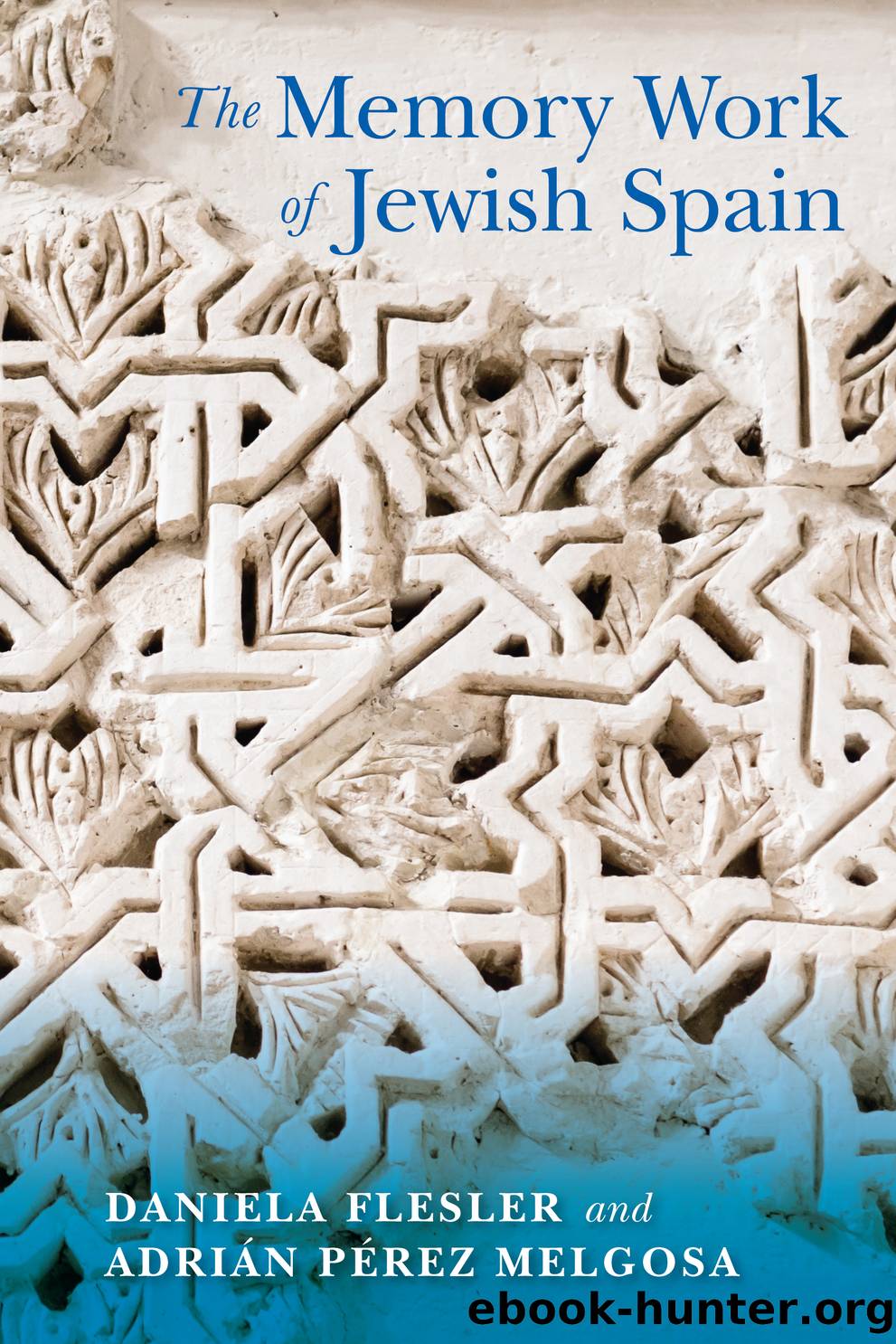The Memory Work of Jewish Spain by Daniela Flesler

Author:Daniela Flesler
Language: eng
Format: epub
ISBN: 9780253050144
Publisher: Indiana University Press
Published: 2020-09-08T00:00:00+00:00
Figure 3.6. Great Prayer Room from Womenâs Gallery balcony, July 2015. ©Adrián Pérez Melgosa.
As we proceed down the stairs to the last exhibition room in the museum, we encounter the contemporary oil portrait Samuel Halevi by Daniel Quintero. We analyze this painting in the context of Quinteroâs work on Spainâs Sephardi memory in chapter 6. In Room 4, dedicated to Sephardi Jews, we encounter an emblematic exhibit contributing to this narrative movement away from destruction and willful effacement of this destruction into restoration and redemption. At first sight, the objects seem simple enough, starting with one more iteration of previous exhibits in the Womenâs Gallery: a studio photograph shows a couple dressed festively. Next to them, two mannequins, one male and one female, stand dressed in similar clothes. The people in the photograph are identified as R. Yishaq Ha-Serfaty and Rahel Obadia. The garments, a label indicates, are part of the traditional Moroccan Sephardi wedding attire. The juxtaposition of photograph and mannequins introduces a reality effect to the exhibit that is further reinforced by the presence, between the two mannequins, of a marriage contract signed on July 2, 1919, by Moisés J. Emergui and Esther J. Moryusef in Larache, Morocco. We also see their paper wedding invitations. In a way similar to the sculptures by Lasry, these objects are resignified through their identifying label. In this case, the caption says that the whole ensemble is on loan from the Emergui family from Alcázar and Larache (Marruecos) and Madrid (see fig. 3.7).
Again, individual identity is foregrounded here. These mannequins are not mere placeholders standing for whole groups of people. The caption transforms the wedding garment exhibit into a story of survival, continuity, and return. The Emergui family wedding garments are thus evidence of a peculiar longue durée narrative, one that, starting at the home of a Sephardi family in Larache in 1919, points both to the past of 1492, when their ancestors left Spain, and to the present, when their descendants live in Madrid. A similar story emerges from the background of the texts that accompany the exhibit. They were written by Jacob Hassán, one of the foremost specialists in Sephardi language, literature, and culture in Spain. Hassán, who died in 2006, was a founding member of the Association of Friends of the Sephardi Museum and member of the museumâs Consejo Asesor CientÃfico. Like Lasryâs, the Pinto-Coriatsâ, and the Emerguisâ, Hassánâs personal story exemplifies this pattern of return to contemporary Spain.33 Together with the works of art, regalia, and narratives connected to present-day Sephardi Jews, these exhibits display something perhaps more important for the museum, the willingness of these returned Sephardi Jews to collaborate with it. This not only serves to legitimate the project of the museum as a whole but also allows the museumâs narrative to culminate in a tale of redemption.
Download
This site does not store any files on its server. We only index and link to content provided by other sites. Please contact the content providers to delete copyright contents if any and email us, we'll remove relevant links or contents immediately.
| Haggadah | Hasidism |
| History | Holidays |
| Jewish Life | Kabbalah & Mysticism |
| Law | Movements |
| Prayerbooks | Sacred Writings |
| Sermons | Theology |
| Women & Judaism |
The Secret Power of Speaking God's Word by Joyce Meyer(2266)
Man's Search for Meaning by Viktor E. Frankl(2266)
Mckeown, Greg - Essentialism: The Disciplined Pursuit of Less by Mckeown Greg(2119)
MOSES THE EGYPTIAN by Jan Assmann(1984)
Unbound by Arlene Stein(1948)
Devil, The by Almond Philip C(1913)
The Complete Dead Sea Scrolls in English (7th Edition) (Penguin Classics) by Geza Vermes(1854)
I Capture the Castle by Dodie Smith(1582)
Schindler's Ark by Thomas Keneally(1523)
The Invisible Wall by Harry Bernstein(1464)
The Gnostic Gospel of St. Thomas by Tau Malachi(1419)
The Bible Doesn't Say That by Dr. Joel M. Hoffman(1377)
The Secret Doctrine of the Kabbalah by Leonora Leet(1273)
The Jewish State by Theodor Herzl(1258)
The Book of Separation by Tova Mirvis(1229)
A History of the Jews by Max I. Dimont(1215)
The Dead Sea Scrolls Bible by Martin G. Abegg(1210)
Political Theology by Carl Schmitt(1194)
Oy!: The Ultimate Book of Jewish Jokes by David Minkoff(1108)
